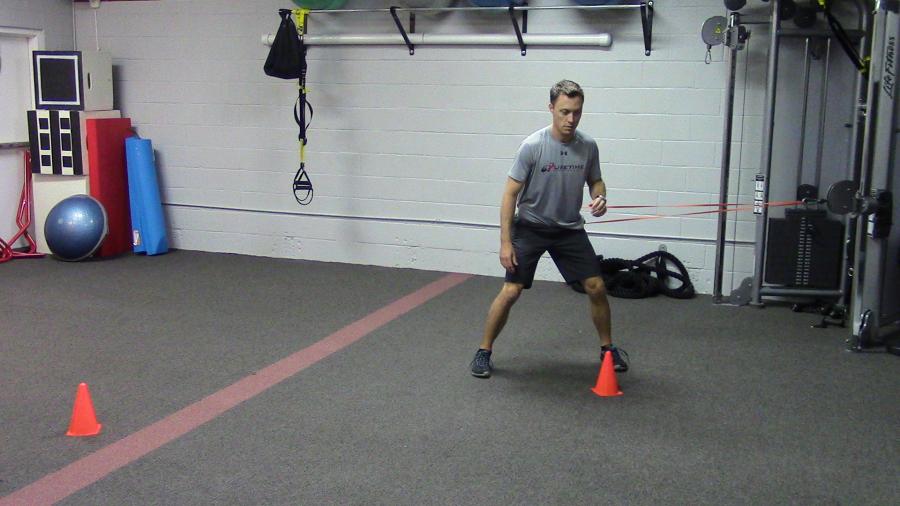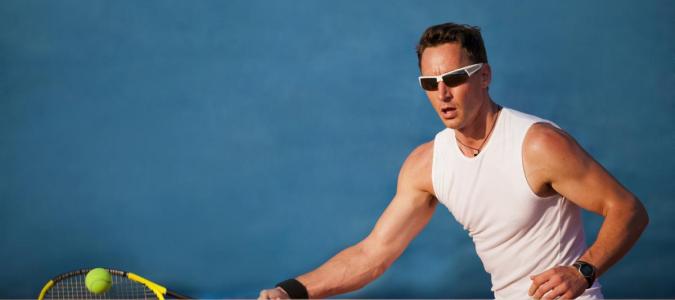
Variations In Lower Body Training For Tennis
Tennis training and these lower body exercises can help players excel. One of my favorite exercises to use with tennis players is the lateral lunge. Be it a recreational or competitive player, lateral movement on the court is of utmost importance. The exercise itself can be quite complex, but has a great carryover affect towards improving one’s ability to decelerate and then accelerate in the opposite direction. The human body has evolved to be very efficient at moving. Whether it was trying to catch dinner or keep from becoming it, we are designed to move and act in diverse ways through multiple planes of motion. Unfortunately, modern life has created an environment where we move much less and in fewer directions. We live in a multi-planar world but have been groomed to exercise and move in a straight ahead manner. In sport as well as in life, we need to be able to move laterally, be it jumping out of the way of a car, or getting to that 100 mph serve.
In tennis, there are on average 3 to 5 directional changes per point. Players spend 80% of stokes played within 2.5 meters of their starting position and 48% of their movements are lateral (side to side). Yet, far too often I see people only training in the sagittal plane. Before we go on we should discuss the three planes of motion, the first being the sagittal plane. The sagittal plane is an imaginary line running through the center of the body dividing it in half from right to left. Movements that run along this imaginary line consist of walking, reaching forward, squats, lunges, bench press, and so on. Then there is the frontal plane, dividing the body from the front and back, movements in the frontal plane would consist of lateral movements and raising your arms out to the side. Last you have the transverse plane that runs horizontally through the body separating the upper and lower body. Movements along the transverse plane would involve rotation of some sort.
Most people and almost all tennis players would benefit from incorporating more lateral and multi-directional exercises to their routine. Not only will it help explosiveness to the ball, but it will help to absorb the stress of trying to stop and cut on a dime, a move that is the cause of many lower body injuries. When we go to cut or plant while in motion, we are asking one leg to absorb a lot of force. The inability of the muscles around the hip, knee, and ankle to absorb that force and control these joints will put them at a high risk of injury. It’s best to develop the patterns for lateral movement in a controlled environment before trying to perform it at 100% effort on the court. This is why I like to start with the lateral lunge and progress from there.
Now don’t get me wrong, I am not saying throw out all your old exercises that have proven the test of time. I am still a fan of the basics, but I like to introduce these new laterally based exercises in the warm up, without resistance. Once the movement is mastered we can progress the client with more advanced versions.
Lateral Lunge:
Take approximately a four foot step out to the right side; when the foot hits the ground begin driving the hip back while also bending the right knee, do not let the knee move too far forward keeping it only slightly in front of the ankle and in line with the toes with out moving past the toes. Keep your torso flat and the left leg straight, keeping both feet flat on the ground. Drive through the right foot extending the hip and knee returning to the starting position. This is a great movement to add into your warm up as most will feel and stretch in the groin of the straight leg. Once you feel comfortable with this exercise the next step would be to add some weight. I prefer dumbbells in each hand or you can also hold one dumbbell in front just under your chin, also known as a goblet squat.
Just keep in mind you probably will not be able to handle as much weight in this direction as you would in a normal lunge.
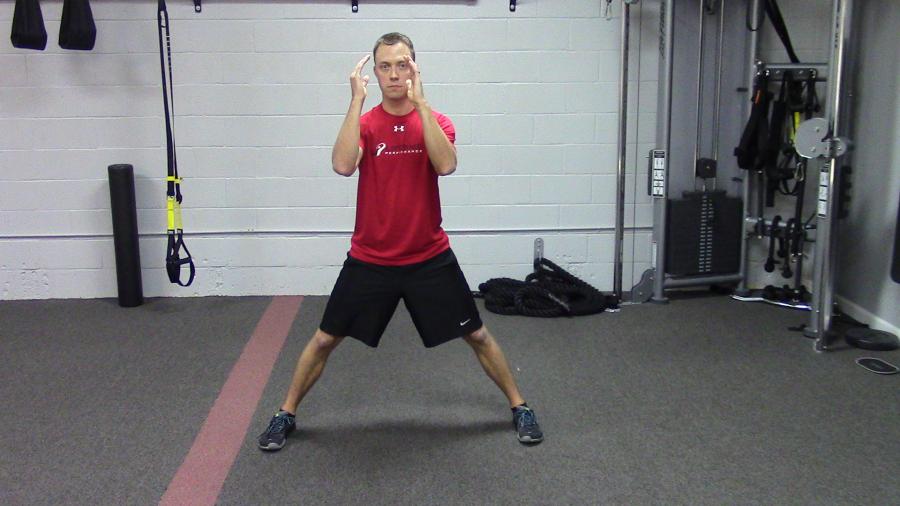
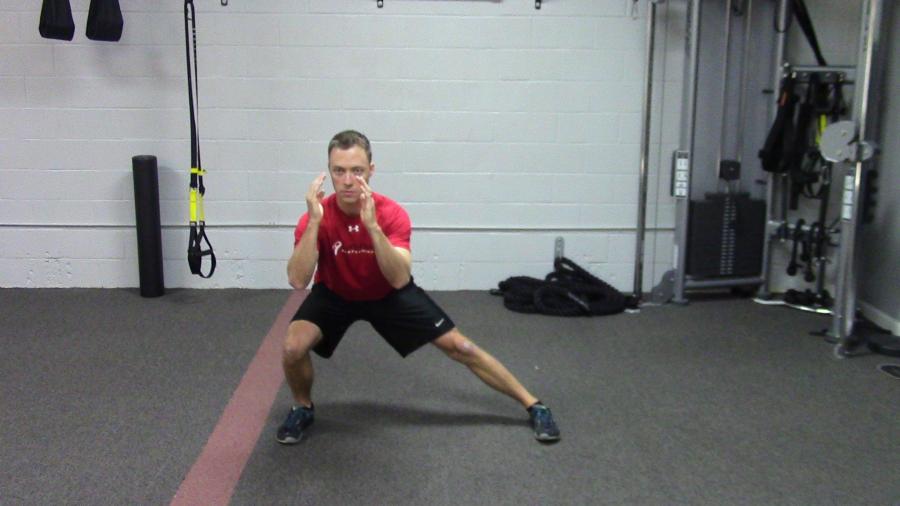
Hint:
My favorite way to clean up someone’s lateral lunge is to have them place their right hand on their right glute (buttocks) and left fingers in to the front of the right hip. When you step out to your right think about pressing your fingers into your hip pushing your glute into your right hand as you sit back and to your right.
Band Resisted Lunges:
What I really like about these is that the band applies a lateral force pulling you outside your center of gravity. The challenge then becomes decelerating that force as you lunge in and then forcefully accelerating in the other direction which mimics the demands of cutting more realistically then that of loading vertically with traditional weights. To perform, take a lateral lunge as you normally would, stepping toward the direction of where the band is trying to pull you. Absorb the force with your inside leg then forcefully propel your self back in the other direction returning to the starting position.
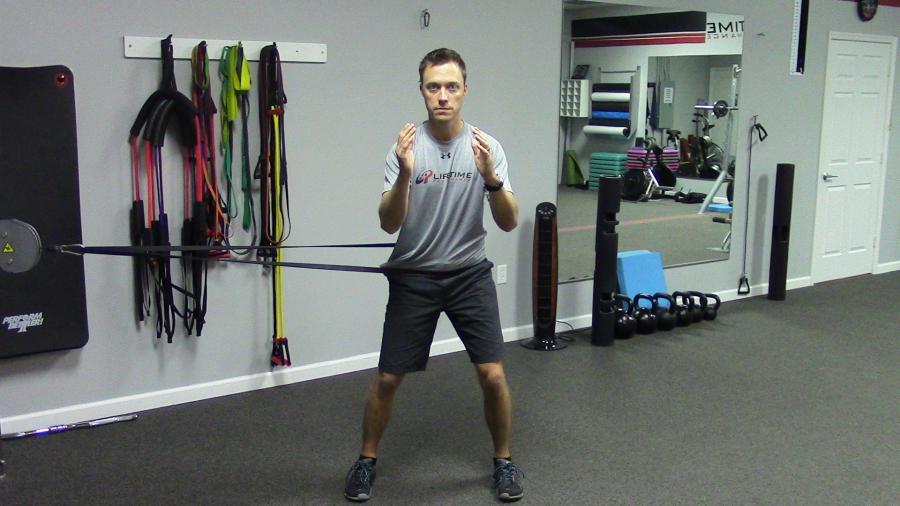

Shuffling:
You can implement shuffling right into your warm up, before working out or playing a match. It’s pretty straight forward; assume an athletic position, as if you were going to receive a serve, then without letting your head raise, shuffle to one side then the other.
Keep your feet from crossing or coming too close to one another. Here are some more challenging ways to incorporate shuffling.
Box Shuffling:
Using a box 4-10 inches high, placing your right foot on the box, use your left foot to push yourself up and over to the right. Moving your right foot to the ground and the left to the box absorb the momentum with your right and quickly repeating back to the left.
Band Resisted Shuffling:
Using a band that you can loop around your waist and fix to a solid object or have some one hold, place a cone to a set distance, shuffle to the cone and with control shuffle back to the starting position keeping tension on the band. This offers similar sport specific similarities as the band resisted lunges.
